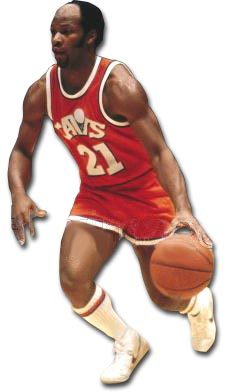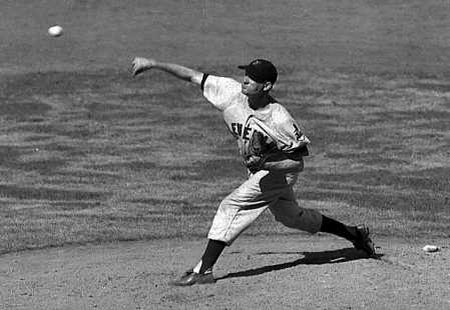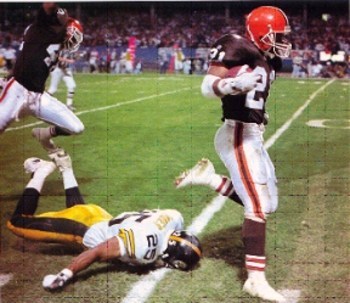 General
General  General Archive
General Archive  Top Cleveland Sports Figures, By the Numbers - #21
Top Cleveland Sports Figures, By the Numbers - #21
 This is one installment in a team effort by The Cleveland Fan, highlighting the top local sports figures by jersey number. Please weigh in with your thoughts, in the Boards. As David Letterman would say, “For entertainment purposes only; please, no wagering.”
This is one installment in a team effort by The Cleveland Fan, highlighting the top local sports figures by jersey number. Please weigh in with your thoughts, in the Boards. As David Letterman would say, “For entertainment purposes only; please, no wagering.”
As unfortunate as it was to have to live through the Browns move to Baltimore, after falling in love with the Marty Schottenheimer teams of the late 80’s who played with the hearts of lions, I feel fortunate that I’m too young to know of the Stepien Era of the NBA in Northeast Ohio. It’s not inconceivable to believe that a decade earlier, the dreadful Cavaliers, owned by the worst owner (possibly) in the history of sports.
For that reason, mostly, we are going to make a questionable here at #21. There’s a number hanging in the rafters at Ontario and Carnegie of the same value, and also a pair of Browns running backs that actually gave us a thrill or two in the color TV era, but they’re all going to get snubbed here in what might appear to be a ridiculous case of name recognition. Truth be told, Lloyd Bernard Free is probably my choice at #21 anyway, but it’s so much more fun to talk about World B. Free.
Free was nicknamed “All-World” by his friends in Brooklyn growing up, but there are some stories around the very trustable internet that the “World” name, which legally became his first name was based on the fact he could make shots from all over the court and all over the world. Free came into the Association out of Guilford College when the 76ers took him with the 23rd overall pick in the draft. He spent three seasons in Philly, before going to Golden State and really making an immediate impact, nearly doubling his scoring average from 15.7 per game to 28.8 in his first season with the Warriors and 30.2 per game in his second season.
 On December 15, 1982, the Cavs sent Ron Brewer (father of current NBA player, Ronnie Brewer) to Golden State, in exchange for Free. Free could still score, but wasn’t the quite the high flying guard he was when he earned the nickname. He’d been written off as a ball-hawk at this point, and positively no one believed he could help the NBA in Cleveland rise from the dead. Between the impossible commute to the prairie of Richfield and the unbearable management style of Ted Stepien, what reason did the fans have to invest any time in the 3-19 Cavaliers?
On December 15, 1982, the Cavs sent Ron Brewer (father of current NBA player, Ronnie Brewer) to Golden State, in exchange for Free. Free could still score, but wasn’t the quite the high flying guard he was when he earned the nickname. He’d been written off as a ball-hawk at this point, and positively no one believed he could help the NBA in Cleveland rise from the dead. Between the impossible commute to the prairie of Richfield and the unbearable management style of Ted Stepien, what reason did the fans have to invest any time in the 3-19 Cavaliers?
Scott Wedman and Cliff Robinson, I’m sure, were decent players, but World B came along and immediately owned the top spot in scoring, average 24.2 in 54 games with Cleveland in 1983. Still, improvement didn’t happen overnight and the Cavs finished 23-59 on the year.
Things were a little better the following year. The team won 28 games and World gave them 22 points per game, but it had not been a few years since the team’s last playoff berth in 1978, so Bill Musselman was out and George Karl was in as the Head Coach.
The Cavs would experience yet another terrible start, going 2-19 before turning things around. Free would average 22 again in this season; combined with decent contributions from Roy Hinson and Phil Hubbard, the Cavs were able to make the playoffs with 36 wins. Many credit World for the turnaround in the standings and with the attendance. Free hit shots from beyond the 3-point arc; unfortunately such an arc had not been painted on the court yet at that point. Still, people were making the trek down 271 to see the 32 year-old play, for the way he played, scoring and passing.
As much of a legend as he was at that point, playing for the young Karl, Free never copped an attitude about playing for the team that traded James Worthy for Don Ford. When Karl used him in a sixth man role, not a peep from the World. When, the experiment of bringing his top scorer in off the bench ran its course, there were no “I told you so” comments to the media. World B Free just played his heart out for a team that no one believed in, thus opening the door for Harper, Price, Nance, and eventually gave LeBron James a local team to be drafted to.
When you look in the rafters at the Q, you won’t see Free’s 21, unless you’re looking at Wayne Ellington presently, but you do see Nate Thurmond. Granted, the Cavaliers set of retired numbers doesn’t represent any type of murderer’s row by any stretch of the imagination, but Free does deserve to be recognized for his brief contributions to the Cavs when their very existence in Ohio was put in jeopardy by Stepien.
For now, all we have are the memories that will hopefully be preserved as stories of the man who remains an ambassador of goodwill for the NBA to this day.
Honorable Mention
 Campy Russell, who the Cavaliers selected with the 8th pick in the 1974 draft out of Michigan, spent ten seasons with the Cavs and was named an All-Star in 1979. The small forward averages 15.8 points per game and now works on the Cavs telecasts for Fox Sports Ohio. He is the runner-up to Free as the best Cav to wear 21, but the rest of the field is highlighted by JJ Hickson, Trajan Langdon, and Darius Miles.
Campy Russell, who the Cavaliers selected with the 8th pick in the 1974 draft out of Michigan, spent ten seasons with the Cavs and was named an All-Star in 1979. The small forward averages 15.8 points per game and now works on the Cavs telecasts for Fox Sports Ohio. He is the runner-up to Free as the best Cav to wear 21, but the rest of the field is highlighted by JJ Hickson, Trajan Langdon, and Darius Miles.
Then, there’s Bob Lemon. I know, it’s a tough sell to give you a player with one playoff win on a team that never had a winning record over a Hall of Famer, a 7-time All-Star, and someone that won a World Championship for Cleveland. Lemon won 20 games in seven different seasons and led the American League in that category three times. He threw a no-hitter in ’48, but he also threw a ton of innings, so he gave up a lot of hits and lost a lot of games. His 207-128 record in 13 seasons with the Indians earned him a call from Cooperstown in 1976. The Indians retired his number in 1998; because it was an available number up until that point, Mike Hargrove wore it his entire career, which began with the Indians in June of 1979. Known as the "Human Rain Delay" for his Betancourt-esque ritual at the plate, "Grover" was the American League Rookie of the Year with Texas in 1975 and an All-Star in 1975 with the Rangers, but will best remembered in these parts for the magical run the Cleveland teams he managed had in the late 90s. Hargrove is the only manager to lead Cleveland to two World Series appearances.
There’s a time and a place for Earnest Byner, who wore #21 for his second go-round with the Browns in 1995, but this isn’t it. Byner was a big supporter of the fans as the team’s relocation became more and more inevitable. Along with Tony Jones and Steve Everitt, the forgotten hero of the Bernie Kosar era was outspoken about how surreal the whole 1995 season was. When he said he loved the fans, you knew he meant it. What fumble? That’s what I say about Byner…but I do understand it’s significance when we speak of Browns history.
 It was hard to figure out what to do with Eric Metcalf when the Browns drafted him out of Texas. You wanted to play running back because he was a matchup nightmare for opposing linebackers, but he was built to be a wide receiver. Actually, he was built to return kicks. Of his 55 career TD, only 13 came as a running back running the football. He returned ten punts and two kickoffs for six points; the former being an NFL record until Devin Hester got his eleventh in 2011. His two returns against Pittsburgh at The Stadium in 1993, good for a 28-23 win, will forever remain one of the great memories of the old Browns for my generation, for years to come.
It was hard to figure out what to do with Eric Metcalf when the Browns drafted him out of Texas. You wanted to play running back because he was a matchup nightmare for opposing linebackers, but he was built to be a wide receiver. Actually, he was built to return kicks. Of his 55 career TD, only 13 came as a running back running the football. He returned ten punts and two kickoffs for six points; the former being an NFL record until Devin Hester got his eleventh in 2011. His two returns against Pittsburgh at The Stadium in 1993, good for a 28-23 win, will forever remain one of the great memories of the old Browns for my generation, for years to come.
Metcalf was a beloved athlete in this town, provided he wasn't going "up the middle".
- NBA Announces 2013-2014 Schedule
- Browns Ink Sharknado
- Sharknado A No-Show For Rookie Camp
- Trent Richardson Out Until Training Camp
- Browns Sign Brandon Jackson
- Carrasco Suspended Eight Games
- Browns Add to Wide Receiver Depth with David Nelson
- Browns Need to Learn from Past Draft Mistakes
- Browns Release Chris Gocong and Usama Young
- Browns Missing on Grimes Disappointing, But Not The End
The TCF Forums
- Official- Browns Coach Search/Rumors
HoodooMan (Tuesday, January 21 2014 1:36 PM) - Movies coming out
rebelwithoutaclue (Tuesday, January 21 2014 12:56 PM) - 2015 Recruiting
jclvd_23 (Tuesday, January 21 2014 12:38 PM) - The 2014 Offseason Thread
Larvell Blanks (Tuesday, January 21 2014 12:25 PM) - Chris Grant's first 3 drafts
Kingpin74 (Tuesday, January 21 2014 10:13 AM) - Mike Brown
YahooFanChicago (Monday, January 20 2014 11:15 PM) - 2014 Hoops Hockey Hijinx
jpd1224 (Monday, January 20 2014 4:44 PM) - 2014 Recruiting
jclvd_23 (Monday, January 20 2014 2:26 PM) - Wish List - #4 Pick
Hikohadon (Monday, January 20 2014 1:26 PM) - #1 overall pick Anthony Bennett
TouchEmAllTime (Sunday, January 19 2014 1:28 PM)


